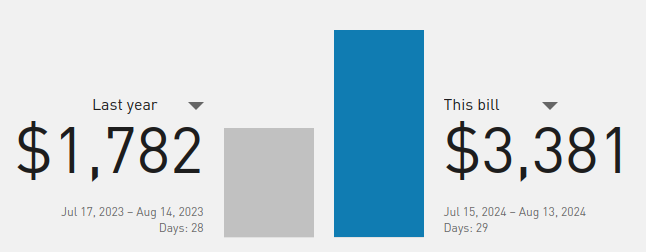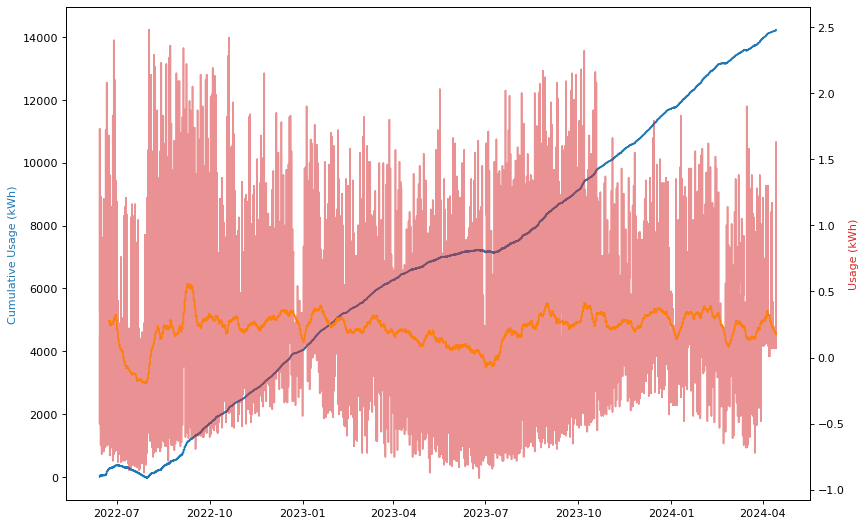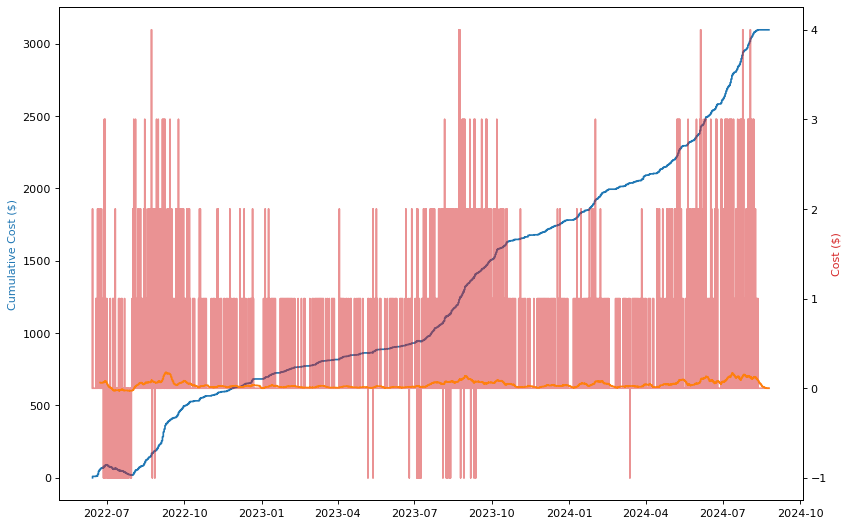The $3,000 "True-up" Bill
Recently, while reviewing upcoming bills, I discovered that my energy bill (electric and natural gas) was going to include my annual "True-up". That bill is going to be for $3,409. I live in California, USA and my energy provider is Pacific Gas & Electric (PG&E).
My home has a solar array on the roof, which means my agreement with PG&E is that I participate in their Net Energy Monitoring (NEM)
What is Net Energy Monitoring (NEM)?
What is a "True-up"?

The True-Up Statement reconciles:
- All your energy-charges and credits
- Any Net Surplus Compensation for the entire 12-month billing cycle
If you have a balance due after all charges and credits are reconciled, that amount will appear on the last PG&E bill of your 12 month billing cycle.
By law, any remaining credits will be reset to zero before the beginning of your new 12-month billing cycle.
So, in a nutshell, some accounting of usage is deferred and is accrued for a once per year payment.
So do you pay nothing until the end of the year?
Perhaps one interpretation of this style of billing is that you would not pay monthly bills, and instead at the end of the year with everything tallied up, you'd pay for the year. But that's not the case.
I still receive monthly bills, set up to auto-pay from my checking account, whose charges look something like this:
| Current PG&E Electric Monthly Charges | $12.53 |
| MCE Electric Generation Charges | $181.85 |
| Current Gas Charges | 23.89 |
| Total Amount Due by 08/09/2024 | $218.27 |
What is my Rate Plan?
The website indicates that my plan is what PG&E calls "Electric Home (E-ELEC)", but my bill indicates that my plan is "Time-of-Use (Peak pricing 4 - 9 p.m. Every Day)". I don't recall intentionally changing to the E-ELEC but here is how PG&E describes it:
Although we have a solar array and inverter, we do not have battery storage, nor is our hybrid electric vehicle capable of storing to then provide back to our home. I can't seem to choose one of the other plans (Time-of-Use, Tiered, Electric Vehicle, or SmartRate™️)
Generation vs. Delivery
In my area, PG&E further offers choices about how your power is generated. You an choose to have PG&E or MCE as the source of your electricity. PG&E handles all of the power delivery. For the life of me, I cannot remember nor figure out what MCE stands for.
Here is an example of the choices and their relative costs that I received an update about in 2023:
| PG&E | MCE Light Green (60% Renewable) | MCE Deep Green (100% Renewable) | |
|---|---|---|---|
| Generation Rate ($/kWh) | $0.13697 | $0.14544 | $0.15544 |
| PG&E Delivery Rate ($/kWh) | $0.20698 | $0.20698 | $0.20698 |
| PG&E PCIA/FE ($/kWh) | $0.01412 | $0.00400 | $0.00400 |
| Total Electricty Cost ($/kWh) | $0.35807 | $0.35642 | $0.36642 |
Back in 2015 when we moved to this house and I was setting up our PG&E account, I chose the MCE Light Green option. I wanted to choose renewable energy sources, but I guess I was a bit noncommittal at the time about going 100% renewable. I'm happy to pay a little bit more to try and do a small part in reducing use of fossil fuel sources. I'm by no means as green as I could or should be, a fact that has been troubling me lately.
So why is my bill so high?
Suspect #1: My Homelab uses too much power
I am a software developer and hobbyist. I tinker with computers a lot and have built out a homelab as part of that hobby. It consists of cheap (to buy) second hand enterprise servers, one of which is powered off 99.9% of the time and the other is powered on 99.9% of the time. It seems like a good candidate for wasteful electricity use.
However, I have had this homelab since 2022 and I have not expanded its equipment nor utilization since then. I did buy an energy monitor to get a better picture of the amount of electricity it uses and to probably spur my in to action of reducing its footprint. My estimate is that this homelab, monitors, and work computer use about $75 a month in electricity. The monitor currently shows $64.03 and I'm about a week away from having monitored for a full month. It also doesn't take in to account time-of-use, so I just set it to assume the cost per kWh is always our maximum rate. Close enough to evaluate.
This is not the culprit, but it is something I plan to make changes to. I need to turn off my personal computer at night, and I probably need to mothball the enterprise server and instead run my hobby software on more efficient hardware that I already have.
Suspect #2: Something else is highly inefficient or using more power
Maybe we're doing more laundry than ever? Maybe the refrigerator in the garage is degrading in efficiency? Maybe charging our hybrid electric car is the cause?
While there are bound to be improvements that can be made, we already do most of our laundry and use the dishwasher outside of peak hours. We have not increased the use of either of those. We bought this car back in April of 2022 and do not drive/charge it any more than we ever have (about 10 miles a day, I'd estimate).
Suspect #3: Rates have increased / NEM 3.0 transition is bad for me
I'll be honest, I don't even know if I'm still grandfathered in to NEM 2.0 or if I'm NEM 3.0 or what. Energysage says that applications made before April 14, 2023 with installations before April 14, 2026 will retain NEM 2.0 status. We had our solar installed well before then, but I don't know if I was supposed to have made submitted some application to retain it. 🤷♂️
Suspect #4: Solar equipment failure
Didn't this system come with monitoring software and an app I can check? Yes well, two things about that. 1) I don't regularly check my solar power generation like I used to and 2) the monitoring works via 2G and I had received several emails informing me that 2G service was being discontinued:
T-Mobile, the cellular carrier network, announced it will be discontinuing its 2G network service on April 2, 2024 and migrating to 4G/5G. This decision was made by T-Mobile and is out of our control. Once the 2G network is shut down, the online monitoring connection to SolarEdge and your installer will be lost.
I did not really take action on this, instead putting it on my long todo list. I felt pretty laid back about addressing it since it only meant the monitoring would no longer work (which, remember, I don't check regularly). Power generation would not be affected.
On August 16th, I received the following email:
Hopefully you're having a great day so far. We are reaching out to you because we happened to come across your system while on the SolarEdge monitoring portal and noticed that your inverter is showing an error. We contacted SolarEdge on your behalf to confirm, and unfortunately the inverter is showing an internal hardware fault and will need to be replaced per warranty. The inverter will be covered per warranty however SolarEdge does not provide any labor reimbursement for any systems older than five years so we would need to charge our in house rates for the repair/replacement.
Well, I was having a great day. No one likes to hear about yet another thing breaking down, covered by warranty or not. On the bright side, they had the equipment in stock, and it got installed just a couple days later. All we had to do was pay around $450 for labor.
What more should I do about it?
PG&E offers lots of "useful" tips and data for monitoring and adjusting your energy use. You can download your usage and billing details sliced in a handful of different ways.
One of the tools they appear to offer is alerting in order to not be surprised by your bill
But when I tried to enable this alert on my account, I received an opaque refusal:

Data is beautiful?
Being the software nerd that I am, I downloaded the data PG&E offers and fired up a Jupyter notebook with Pandas and Matplotlib.


Graphs of electricity usage and cost
Something is not quite right. Either my code is wrong 🤔, PG&E's data is wrong 🤷♂️, or a combination of the two. The plot of cost seems to show a cumulative total of a little more than $3,000 since July of 2022! The bill is for September 2023 to September 2024 and is $3,409! Their data differs in format depending on how far back you go. For the most recent billing period or two it includes both the energy they sent (import) and the energy you sent to them (export), but further back in history it just include usage, which I assume is net usage. I should go look for documentation about their schema.
My conclusion is that this true-up bill is due mostly because of the inverter failing. I don't yet know how long it was not delivering power, I'm waiting to hear back on that. Regardless, I need to take some actions to reduce electricity use.